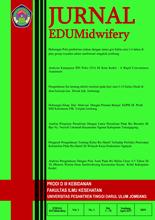Hubungan Pola Pemberian Makan Dengan Status Gizi Balita Usia 3-4 Tahun Di Play Group Irsyadus Salam Sumbersari Megaluh Kabupaten Jombang
Abstract
Abstract
Objective: The incidence rate of nutritional deficiencies is a case rife in Indonesia, ranging from nutritional deficiencies and malnutrition below the red lines under 5 years of age (infants) are groups who are vulnerable to nutritional health problems. Among problems BGM (Down Red Lines) where weight is below the red line limit or less. Methods: The design is an analytic with cross sectional approach, the population in this study is a mother who has children aged 3-4 years in Play Group Irsyadus Salam Sumbersari Megaluh Jombang, as many as 40 respondents sampling is done by purposive sampling as many as 30 respondents. To determine the feeding patterns with questionnaires and nutritional status of children with a view KMS, to determine the relationship of two variables using the Spearman Correlation with SPSS 13 with a level of significance µ = 0,05.
Results: The better the feeding patterns of a toddler the better the nutritional status of children are, this is due to the consumption of food affect the nutritional status of a person, everyday foods that will either provide all the nutrients needed for the body, so if consumption of food a person good the nutritional status will be good too and vice versa. There is a relationship between feeding patterns and nutritional status of children aged 3-4 years in Play Group Irsyadus Salam Megaluh Jombang.
Keywords: Feeding Patterns, Nutritional Status.

